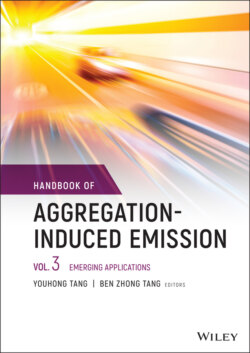Читать книгу Handbook of Aggregation-Induced Emission, Volume 3 - Группа авторов - Страница 44
3.4 AIE‐doped Polymer Films for Energy Harvesting
ОглавлениеRecently, high‐quantum‐yield (ΦF) AIEgens have also been utilized as solar‐harvesting species dispersed into polymers for the preparation of LSCs [88–93]. Sunlight concentration is one of the most effective strategies to reduce the price of electrical power generated by silicon‐based PV solar cells [94]. It is reported that compared to imaging concentrators based on lenses and mirrors, nonimaging LSC demonstrates several advantages, such as low weight, high theoretical concentration factors, ability to work well with diffuse light, and no need for sun tracking or cooling apparatuses [95, 96]. LSCs were first conceived more than 50 years ago by Garwin [97, 98] and are made by a slab of a highly transparent material like glass or plastics like PMMA, PC, or epoxy resins doped by a certain content of a fluorophore. The light that enters the slab is absorbed by a luminescent species and is re‐emitted at longer wavelengths. Because the refractive index of the slab is higher (n = 1.5 for glass or PMMA) than that of air (n = 1), a fraction (theoretically about 75%) of the radiation remains trapped within the matrix due to total internal reflection (TIR) and concentrated at the edges of the plate. PV cells glued at such edges collect the outgoing radiation and produce electric power (Figure 3.11).
Figure 3.11 Working mechanism of an LSC (left) and potential application of the PSC–PV systems in the urban architecture.
Notwithstanding the importance of these plastic solar collectors to diffuse the use of PVs in the urban environment, their utilization is limited due to waveguide losses that adversely affect light concentration to PV cells. LSC loss of performances is often attributed to fluorophore issues including fluorescence quenching due to aggregation and autoabsorption losses [96, 99]. Commercially available aromatic fluorophores display a tendency to π ‐stack, which affects their emission quantum efficiency due to the typical ACQ phenomenon at large content. A low‐fluorophore concentration in the polymer film or slab is considered useless, its capability to harvest sunlight being modest. For example, the perylene bisimide Lumogen F Red 305 (BASF) is considered the best fluorophore for LSCs [96], but cost issues might also limit the diffusion of the LSC–PV technology. Conversely, fluorophores with AIE characteristics would be the best candidates for the LSC systems since highly emissive polymer blends can be effectively obtained even at large fluorophore concentration, thus favoring the required solar‐harvesting features [100]. Moreover, the easy chemical modification of several AIE cores opens to economic and scalable synthetic routes that enable the functionalization of the AIE unit with donor–acceptor functional groups. This strategy favors the downshifting of the fluorescence maximum in order to cover the wavelength window characterized by the highest light/electric current conversion by the Si‐based PV cell [101]. In connection with these findings, a red‐emitting TPE derivative (TPE‐AC) was proposed for the first time in a proof‐of‐concept study as a potential AIEgen for the development of high‐performance LSC [42, 102, 103]. The red‐emitting TPE was composed of donor dimethylamine and acceptor malononitrile groups and showed intense emission in the aggregated state close to the near‐infrared (NIR) wavelength window and a good photostability [104]. Different TPE‐AC‐doped PMMA and PC films were prepared and tested as a function of the AIEgen content. Owing to the higher TPE‐AC compatibility within the PC matrix, well‐homogeneous films with superior light‐harvesting features were gathered and with maximum optical efficiencies of 6.7%. This data resulted in promising but still lower than those recorded in the literature for the traditional fluorophore‐based LSC. The same approach was adopted by Ghiggino et al. [105–107] who proposed the dispersion of 10 wt.% of TPE in PMMA thin films, reaching ΦF of about 40% and very low autoabsorption losses even at a geometric factor (G) >100. Nevertheless, the formation of organic microcrystals of TPE strongly contributed to the formation of scattering points that affected the overall LSC performances. In order to increase the LSC performances, the same authors [108] introduced two different fluorophores in the same solar collectors in order to combine their absorption spectra and preserving ΦF by means of efficient energy cascade pathways such as the fluorescence resonance energy transfer (FRET) [109–112]. As designed, a strong‐emitting AIEgen was able to transfer its excitation to an acceptor whose red‐shifted emission strongly reduced the dissipative autoabsorption phenomena, thus enhancing solar‐harvesting and LSC performances [106].
Pucci et al. shifted their attention to the compatibility issues that adversely affected the performances of LSC based on the TPE‐AC AIEgen. Notably, red‐emitting PMMA polymers (PMMA_TPE_RED) prepared via ATRP, already reported by the same authors as vapochromic plastic films, were effectively utilized as solar collectors (Figure 3.12) [113].
Figure 3.12 Chemical structure of the PMMA_TPE_RED and photo of the derived LSC obtained by casting a solution of the polymer over a glass slab of G = 16.6 under the illumination with a solar simulator.
ATRP was actually exploited to obtain the desired polymeric AIEgen architecture aimed at providing phase stability between the fluorophore and the polymer matrix, which is an essential characteristic for high‐performance LSC. Notably, red‐emitting PMMA_TPE_RED films showed a ΦF of 26.5%, and in dispersion with 50 wt.% of PMMA, it provided 30‐μm thick blend films with max optical efficiencies of 10%. This result was reported the highest ever registered with the same G factor (16.6) and therefore consistent for the AIEgen utilization in LSC technology.
